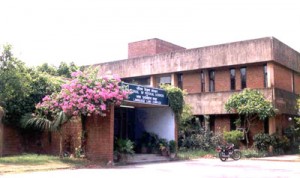
Image of School of Physical Sciences
The research and teaching contributions of SPS have been acknowledged in many ways. The SPS graduates (Pre-Ph.D./Ph.D. and M.Sc.) have found subsequent positions with great ease. Many of the faculty members are frequent speakers at national and international conferences. The faculty and students regularly publish research papers in the best international journals. Some faculty members have received prestigious national awards and been elected fellows of important scientific academies. The UGC has recognized the research excellence of SPS by granting it the DRS (Phase I) scheme in 1994. This was upgraded to DRS (Phase II) in 1999, and DRS (Phase III) in 2004. The DRS activity was further augmented by the UGC-COSIST scheme for the period 2000-2004. Apart from the UGC support, SPS also received major funding from the DST under the FIST program in 2002, and again in 2007. It is also worth mentioning that SPS faculty members have attracted considerable individual support through research projects from DST, DBT, CSIR, etc.
SPS is a standard stopping point for many renowned physicists from all over the world and a vigorous seminar program is one of the most valued features of the departmental life. Before proceeding to present detailed facts about the School, it is relevant to remark on the SPS milieu. SPS is a particularly democratic school, with vigorous debate on all matters – academic or otherwise. There has never been a strong hierarchical structure in SPS, with the result that faculty, students and staff have all been involved in most decision-making processes. This process has continually energized the School and resulted in a progressive and close-knit department.
The School offers a Ph.D. (Physical Sciences/Chemical Sciences/Mathematical Sciences) and an M.Sc. (Physics) degree programme.
Experimental Facilities:
Experiments performed in laboratories are crucial to the understanding of natural phenomena, and are an integral part of research and training in the physical sciences. Balanced growth of experimental activities with sound theoretical understanding forms the backbone of our programmes.
The materials laboratory at SPS has embarked on the task of preparation of magnetic alloys and study of their properties (resistivity, thermopower, magnetic susceptibility, etc. both at room temperature and far below it, using a closed-cycle Helium refrigerator and a 2-Tesla magnet. A precision low-cost vibrating-sample magnetometer has been designed and fabricated in the laboratory. A Mossbauer set-up provided the microscopic details of dynamics of lattice and hyperfine interactions in the solid state. Using facilities at the nearby Intra-University Accelerator Centre (formerly Nuclear Science Centre), the National Physical Laboratory and the Solid State Physics Laboratory, the exciting field of ion-beam interaction with solids and surfaces, the processes of electronic energy relaxation and atomic motion are studied. In the semiconductor physics laboratory, optical and transport properties of technologically important wide-band-gap inorganic and organic semiconductors are studied, along with semiconductor devices, quantum dots and hetero-structures using photo luminescence and different electrical spectroscopic techniques. The laboratory is equipped with a clean room and a vacuum coating unit for preparation of thin films. Experimental facilities available in the field of nonlinear and quantum optics include a high-power laser; acousto-optic modulators and sensitive photon detection systems; an automated digital storage oscilloscope; and vibration-isolated optical table. A recently commissioned scanning probe microscope provides details of topography and electronic properties of materials at the atomic level.
A major SPS objective has been to focus research activities in areas interfacing physics and chemistry. The problems of interest in the School are the physical characterization of bio-polymers, colloidal and micelle phenomena, dynamics of sol-gel and glass transitions, study of micro emulsions and other complex fluids. The research laboratories are currently equipped with a diode-pumped solid state laser (ND:YAG), a piezo-electric driven multi-pass Fabry-Perot interferometer; a digital correlator, a digital scanning calorimeter, and a dielectric relaxation apparatus with required accessories. The soft condensed matter group has a strong collaboration with Bhabha Atomic Research Centre, Mumbai, and uses the small-angle neutron and X-ray scattering facilities there. In addition, there is an active collaborative research programme with DU and NII to develop a nano-based biosensor. The School has acquired a high resolution Rheometer for studying relaxation in complex fluids. It has also procured a high-precision zeta potential instrument.
A cryogen-free superconducting magnet along with a variable temperature insert has been installed in SPS since July 2005. This has been a funded through the FIST programme of DST. The system successfully operates in the temperature range 1.6 K to 300 K and produces up to 8T magnetic field. Various material characterization techniques such as resistivity, Hall effect, magnetoresistance, and RF penetration depth have been integrated into the system. The interfacing software and automation have been developed at JNU. A series of superconductors, Manganites, and diluted magnetic semiconductors have already been studied using this low temperature-high magnetic field facility.
A radio-frequency sputtering system has also been installed in SPS from the FIST funding. The system has been integrated by Hindivac Pvt. Ltd., Bangalore. Turbo-molecular pump and RF power supply have been imported and assembled in the RF sputtering system. Thin films with a thickness of 50-200 nm of metal (Cu and Al) and oxides (ZnO and SiO2) have been grown.
The experimental facilities of the School are also being used by scientists from other universities and institutes. For example, the laser-light scattering facility is being used by M.S. University, Baroda, G.N.D. University, Amritsar, Delhi University, South Campus, National Institute of Immunology, New Delhi and IUC-DAE, Mumbai. The APM facility is being used by SSPL, Delhi, IIT, Delhi, RRI, Bangalore, Intra-University Accelerator Centre, New Delhi, and Delhi University, Delhi.
Computational Facilities:
In the recent past, computer simulation of physical problem has played an important role in the development of physics and chemistry, particularly in the context of systems with nonlinearities and many degrees of freedom. It has now built up its computing facilities to a reasonable level. It has several high-speed workstations (Silicon Graphics machines, Compaq XP 1000 and SUN Ultra 60s) to facilitate heavy computing.